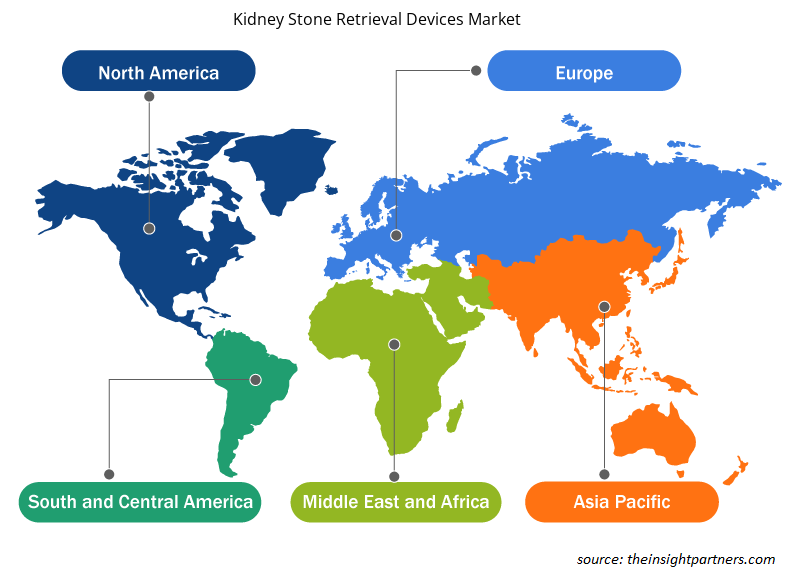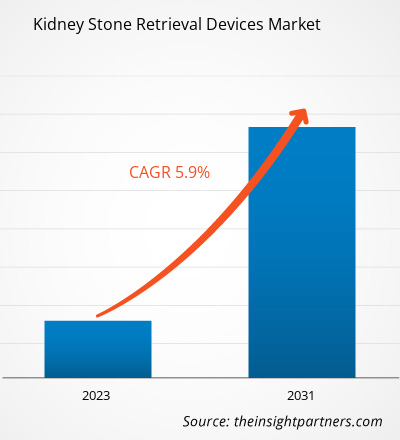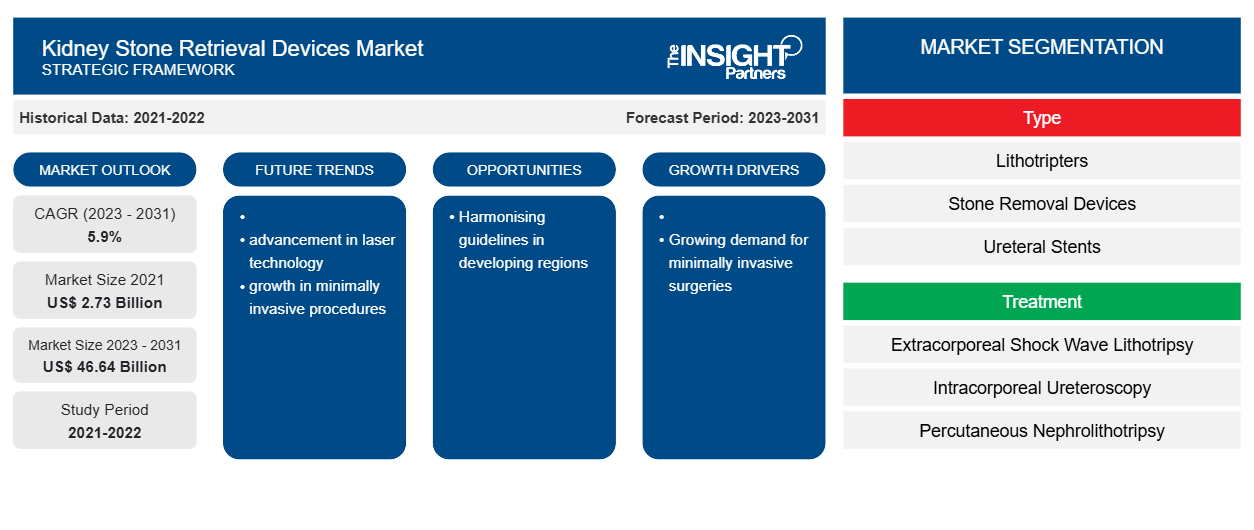Si stima che le dimensioni del mercato dei dispositivi per il recupero dei calcoli renali siano state di 2,73 miliardi di dollari USA nel 2021 e di XX miliardi di dollari USA nel 2023 e si prevede che raggiungeranno i 46,64 miliardi di dollari USA entro il 2031; si stima che registrerà un CAGR del 5,9% entro il 2031. È probabile che la preferenza per gli interventi chirurgici robotici per le malattie renali rimanga una delle principali tendenze del mercato dei dispositivi per il recupero dei calcoli renali.
Analisi di mercato dei dispositivi per il recupero dei calcoli renali
I lanci di prodotti catalizzano in modo significativo la crescita del mercato dei dispositivi per il recupero dei calcoli renali. Le aziende si stanno concentrando ampiamente sullo sviluppo di dispositivi utilizzati per eseguire procedure chirurgiche minimamente invasive. Ad esempio, a gennaio 2023, Boston Scientific ha lanciato il dispositivo di distribuzione del recupero LithoVue Empower negli Stati Uniti e in Europa. Il dispositivo è utilizzato per il recupero dei calcoli renali tramite ureteroscopia flessibile (URS) ed è indicato per l'uso con l'ureteroscopio digitale flessibile monouso LithoVue e il cestello di recupero in nitinol compatibile. Il dispositivo consente il funzionamento simultaneo di un ureteroscopio e di un cestello. I progressi tecnologici nel prodotto semplificano le procedure e aiutano a raccogliere e rimuovere il calcolo. Tali procedure minimamente invasive sono ampiamente adottate per recuperare i calcoli renali dalle persone anziane. I dispositivi utilizzati in queste procedure riducono il tempo necessario per l'intervento chirurgico e la durata della degenza ospedaliera, oltre a consentire una rapida guarigione.
Panoramica del mercato dei dispositivi per il recupero dei calcoli renali
Il mercato globale dei dispositivi per il recupero dei calcoli renali è segmentato per regione in Nord America, Europa, Asia Pacifico, Medio Oriente e Africa e Sud e Centro America. La regione del Nord America detiene la quota di mercato più grande del mercato, mentre la regione dell'Asia Pacifico è la regione in più rapida crescita. La crescita in Nord America è determinata dalla crescente incidenza dei calcoli renali in tutti i paesi, dall'aumento della spesa sanitaria per le malattie renali croniche e dal crescente sostegno governativo tramite l'introduzione di linee guida per il trattamento dei calcoli renali. D'altro canto, si prevede che la mancanza di competenze richieste per le procedure minimamente invasive ostacolerà la crescita del mercato.
Personalizza questo report in base alle tue esigenze
Riceverai la personalizzazione gratuita di qualsiasi report, comprese parti di questo report, o analisi a livello nazionale, pacchetto dati Excel, oltre a usufruire di grandi offerte e sconti per start-up e università
-
Scopri le principali tendenze di mercato in questo rapporto.Questo campione GRATUITO includerà analisi di dati che spaziano dalle tendenze di mercato alle stime e alle previsioni.
Driver di mercato e opportunità per i dispositivi di recupero dei calcoli renali
La crescente domanda di interventi chirurgici minimamente invasivi favorirà il mercato
Nel corso del tempo, si è verificata una crescita significativa della prevalenza delle malattie renali, che ha portato a un aumento delle procedure chirurgiche. Le procedure chirurgiche invasive presentano fattori di rischio elevati e i pazienti impiegano più tempo per riprendersi. Queste procedure presentano un rischio elevato di infezioni e un tasso elevato di complicazioni a livello globale. Per superare le conseguenze associate alle procedure invasive, gli operatori sanitari preferiscono le procedure minimamente invasive. Gli operatori sanitari sono più propensi a seguire le procedure minimamente invasive a causa di vari vantaggi, come periodi di recupero più brevi, complicazioni molto limitate o nulle, alti tassi di successo e riduzione dei tempi di procedura. Negli ultimi anni, la chirurgia minimamente invasiva è diventata sempre più popolare per il trattamento dei calcoli delle vie urinarie superiori. L'Associazione europea di urologia raccomanda sia la nefrolitotomia percutanea (PCNL) sia la chirurgia intrarenale retrograda (RIRS) per i calcoli con un diametro inferiore a 2 cm. La PCNL è la prima scelta per i calcoli con un diametro superiore a 2 cm. Con l'avanzamento degli strumenti endoscopici e della tecnologia minimamente invasiva, la PCNL tradizionale si è evoluta in Mini-PCNL, Ultra-mini PCNL, Super-mini PCNL, Micro-pcnl e altre procedure minimamente invasive. Inoltre, un aumento delle procedure minimamente invasive ha portato al lancio di prodotti e allo sviluppo di strumenti specializzati che aiutano durante l'intervento chirurgico. I risultati positivi degli interventi chirurgici minimamente invasivi hanno aumentato l'inclinazione verso interventi chirurgici minimamente invasivi per calcoli renali, poiché gli operatori del mercato si concentrano sullo sviluppo e sul lancio di prodotti avanzati. percutaneous nephrolithotomy (PCNL) and retrograde intrarenal surgery (RIRS) for stones with a diameter less than 2 cm. PCNL is the first choice for stones with a diameter greater than 2 cm. With the advancement of endoscopic instruments and minimally invasive technology, traditional PCNL has evolved into Mini-PCNL, Ultra-mini PCNL, Super-mini PCNL, Micro-pcnl, and other minimally invasive procedures. Additionally, an increase in minimally invasive procedures led to product launches and development of specialized instruments that help during the surgery. The positive outcomes of minimally invasive surgeries have increased the inclination toward minimally invasive kidney stone surgeries as market players are focused on development and launch of advanced products.
Armonizzazione delle linee guida per il recupero dei calcoli renali nelle regioni in via di sviluppo: un’opportunità
Si prevede che l'armonizzazione delle linee guida per le procedure di recupero dei calcoli renali rappresenti un'opportunità fondamentale per la crescita degli operatori del mercato globale. In regioni come l'Asia Pacifica e il Medio Oriente, i calcoli renali vengono rimossi tramite procedure di pielolitotomia aperta/laparoscopica e ureterolitotomia. Analogamente, in paesi come Corea, Giappone e Turchia, la chirurgia intrarenale combinata endoscopica (ECIRS) è tra le procedure ampiamente preferite e, nei casi pediatrici, la litotrissia a onde d'urto (SWL) è la procedura standard eseguita. Tuttavia, a causa di fattori come la mancanza di consapevolezza riguardo alle procedure minimamente invasive, gli ambienti sociali, economici ed etnici nei paesi asiatici e mediorientali, vi è un'enorme differenza nella pratica clinica delle procedure di recupero dei calcoli renali. In alcuni paesi dell'Asia Pacifica, vi è una preferenza limitata per procedure come RIRS, ureteroscopia (URS) e PCNL. I vantaggi conferiti da queste procedure probabilmente miglioreranno la salute pubblica e stimoleranno il mercato dei dispositivi di recupero dei calcoli renali. Pertanto, per aumentare il numero di procedure minimamente invasive, l'Urological Association of Asia ha fornito linee guida asiatiche sviluppate per tutti i domini urologici nel continente. Le linee guida sono state sviluppate con l'assistenza di rappresentanti esperti dell'American Urological Association e dell'European Association of Urology. Pertanto, lo sviluppo di linee guida asiatiche sarà allineato con gli standard dell'American Urological Association e dell'European Association of Urology, poiché sono considerati standard una volta. Si prevede che l'introduzione di tali linee guida uniformi standardizzerà il processo di sviluppo di dispositivi di recupero renale nei prossimi anni.
Analisi della segmentazione del rapporto di mercato sui dispositivi di recupero dei calcoli renali
I segmenti chiave che hanno contribuito all'analisi di mercato dei dispositivi per il recupero dei calcoli renali sono tipologia, trattamento e utente finale.
- In base al tipo, il mercato dei dispositivi per il recupero dei calcoli renali è segmentato in litotritori, dispositivi per la rimozione dei calcoli, stent ureterali e ureterorenoscopi. Il segmento dei litotritori ha detenuto la quota di mercato maggiore nel 2023.
- In base al trattamento, il mercato è segmentato in litotrissia extracorporea a onde d'urto (ESWL), ureteroscopia intracorporea e nefrolitotrissia percutanea. Il segmento della litotrissia extracorporea a onde d'urto (ESWL) ha detenuto la quota maggiore del mercato nel 2023.
- In termini di utente finale, il mercato è segmentato in ospedali e cliniche, cliniche specialistiche e centri chirurgici ambulatoriali. Il segmento ospedali e cliniche ha dominato il mercato nel 2023.
Analisi della quota di mercato dei dispositivi per il recupero dei calcoli renali per area geografica
L'ambito geografico del rapporto di mercato sui dispositivi di recupero dei calcoli renali è principalmente suddiviso in cinque regioni: Nord America, Asia Pacifico, Europa, Medio Oriente e Africa e Sud America/Sud e Centro America. Il Nord America è il mercato più grande per i dispositivi di recupero dei calcoli renali, con gli Stati Uniti che detengono la quota di mercato maggiore, seguiti dal Canada. Si prevede che il mercato dei dispositivi di recupero dei calcoli renali crescerà a causa della crescente incidenza dei calcoli renali nei paesi, dell'aumento della spesa sanitaria per le malattie renali croniche e del crescente sostegno governativo tramite l'introduzione di linee guida per il trattamento dei calcoli renali. Inoltre, si prevede che il crescente turismo medico in Messico, che offre il trattamento dei calcoli renali a un prezzo inferiore, creerà opportunità di crescita per la crescita del mercato. Si prevede che l'Asia Pacifico crescerà con il CAGR più elevato nei prossimi anni.
Approfondimenti regionali sul mercato dei dispositivi per il recupero dei calcoli renali
Le tendenze regionali e i fattori che influenzano il mercato dei dispositivi di recupero dei calcoli renali durante il periodo di previsione sono stati ampiamente spiegati dagli analisti di Insight Partners. Questa sezione discute anche i segmenti e la geografia del mercato dei dispositivi di recupero dei calcoli renali in Nord America, Europa, Asia Pacifico, Medio Oriente e Africa e America meridionale e centrale.

- Ottieni i dati specifici regionali per il mercato dei dispositivi di recupero dei calcoli renali
Ambito del rapporto di mercato sui dispositivi di recupero dei calcoli renali
| Attributo del report | Dettagli |
|---|---|
| Dimensioni del mercato nel 2021 | 2,73 miliardi di dollari USA |
| Dimensioni del mercato entro il 2031 | 46,64 miliardi di dollari USA |
| CAGR globale (2023-2031) | 5,9% |
| Dati storici | 2021-2022 |
| Periodo di previsione | 2023-2031 |
| Segmenti coperti |
Per tipo
|
| Regioni e Paesi coperti |
America del Nord
|
| Leader di mercato e profili aziendali chiave |
|
Dispositivi per il recupero dei calcoli renali: densità degli attori del mercato: comprendere il suo impatto sulle dinamiche aziendali
Il mercato dei dispositivi per il recupero dei calcoli renali sta crescendo rapidamente, spinto dalla crescente domanda degli utenti finali dovuta a fattori quali l'evoluzione delle preferenze dei consumatori, i progressi tecnologici e una maggiore consapevolezza dei benefici del prodotto. Con l'aumento della domanda, le aziende stanno ampliando le loro offerte, innovando per soddisfare le esigenze dei consumatori e capitalizzando sulle tendenze emergenti, il che alimenta ulteriormente la crescita del mercato.
La densità degli operatori di mercato si riferisce alla distribuzione di aziende o società che operano in un particolare mercato o settore. Indica quanti concorrenti (operatori di mercato) sono presenti in un dato spazio di mercato in relazione alle sue dimensioni o al valore di mercato totale.
Le principali aziende che operano nel mercato dei dispositivi per il recupero dei calcoli renali sono:
- Società scientifica di Boston
- Società Olimpo
- BD
- Cucinare
- Gruppo Coloplast
- Dornier MedtechTactus
Disclaimer : le aziende elencate sopra non sono classificate secondo un ordine particolare.

- Ottieni la panoramica dei principali attori del mercato dei dispositivi per il recupero dei calcoli renali
Notizie di mercato e sviluppi recenti sui dispositivi per il recupero dei calcoli renali
Il mercato dei dispositivi per il recupero dei calcoli renali viene valutato raccogliendo dati qualitativi e quantitativi dopo la ricerca primaria e secondaria, che include importanti pubblicazioni aziendali, dati associativi e database. Di seguito è riportato un elenco degli sviluppi nel mercato dei disturbi del linguaggio e della parola e delle strategie:
- Nel febbraio 2023, Ethicon, un'azienda Johnson & Johnson MedTech, ha annunciato che il primo paziente era stato sottoposto a una procedura robotica assistita per la rimozione di calcoli renali utilizzando la piattaforma MONARCH per urologia. La procedura è stata completata con successo da UCI Health, l'impresa clinica dell'Università della California, Irvine, come parte di uno studio clinico. La piattaforma MONARCH per urologia è stata utilizzata per eseguire la prima procedura di accesso percutaneo guidato elettromagneticamente (EM) e mini-nefrolitotomia percutanea (PCNL) assistita da robot. (Fonte: Johnson & Johnson, comunicato stampa, 2023)
Copertura del rapporto di mercato e risultati dei DISPOSITIVI PER IL RECUPERO DEI CALCOLI RENALI
Il rapporto "Dimensioni e previsioni del mercato dei dispositivi di recupero dei calcoli renali (2021-2031)" fornisce un'analisi dettagliata del mercato che copre le seguenti aree:
- Dimensioni e previsioni del mercato a livello globale, regionale e nazionale per tutti i segmenti di mercato chiave coperti dall'ambito
- Dinamiche di mercato come fattori trainanti, vincoli e opportunità chiave
- Principali tendenze future
- Analisi dettagliata delle cinque forze PEST/Porter e SWOT
- Analisi di mercato globale e regionale che copre le principali tendenze di mercato, i principali attori, le normative e gli sviluppi recenti del mercato
- Analisi del panorama industriale e della concorrenza che copre la concentrazione del mercato, l'analisi della mappa di calore, i principali attori e gli sviluppi recenti
- Profili aziendali dettagliati
- Analisi storica (2 anni), anno base, previsione (7 anni) con CAGR
- Analisi PEST e SWOT
- Valore/volume delle dimensioni del mercato - Globale, Regionale, Nazionale
- Industria e panorama competitivo
- Set di dati Excel
Report recenti
Testimonianze
Motivo dell'acquisto
- Processo decisionale informato
- Comprensione delle dinamiche di mercato
- Analisi competitiva
- Analisi dei clienti
- Previsioni di mercato
- Mitigazione del rischio
- Pianificazione strategica
- Giustificazione degli investimenti
- Identificazione dei mercati emergenti
- Miglioramento delle strategie di marketing
- Aumento dell'efficienza operativa
- Allineamento alle tendenze normative























 Ottieni un campione gratuito per - Mercato dei dispositivi per il recupero dei calcoli renali
Ottieni un campione gratuito per - Mercato dei dispositivi per il recupero dei calcoli renali